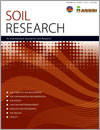SR11199 Electromagnetic induction sensing of soil identifies constraints to the crop yields of north-eastern Australia
Salinity, sodicity, acidity, and phytotoxic concentrations of chloride in soil are major constraints to crop production in many soils. These constraints vary both spatially across the landscape and vertically within soil profile. We identified spatial variability of soil constraints using electromagnetic induction sensing of soil. This will allow farmers to tune management to the potential of the land, which will, in turn, bring economic and environmental benefits.




